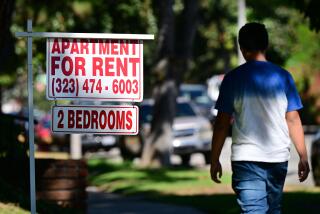Southland home prices rise the least since 2012
Southern California home prices in April rose at their slowest clip in more than a year, a welcome sign for would-be buyers who have been priced out of the housing market.
Sticker shock has taken some wind out of the housing recovery in the last year. Higher prices and mortgage rates have pushed many families and investors to the sidelines, causing sales to tumble and prices to moderate.
For the first time since September 2012, more than one Southland county posted annual price increases that weren’t in the double digits, research firm DataQuick said Tuesday. In Orange County, the median home price rose 7.7% from April 2013 to $576,000, and prices in San Diego climbed 8.7% to $435,000. In March, home prices increased 14.9% in O.C. and 12.4% in San Diego.
Overall, the Southern California median price climbed 13.2% from a year earlier to $404,000, the smallest gain since September 2012.
Most economists say they see the moderation in prices as a stabilizing influence, not an indicator of a downturn. The shocking gains seen last year were simply unsustainable, they said, and the recent slowdown has positives: It’s assuaged concerns of another housing bubble.
But price increases will continue, as will the housing recovery, predicted Christopher Thornberg of research firm Beacon Economics. The region’s economy, he said, is improving and population is on the upswing.
“There is no way prices will fall,” he said, adding there is simply too much demand and not enough supply.
Richard Green, director of USC’s Lusk Center for Real Estate, said he also doesn’t expect a downturn, but neither does he see much price appreciation.
“Prices now are about where they should be — given how high rents are in Los Angeles,” he said.
There are signs that demand may be returning. Sales in the six-county region climbed 13.4% in April from March, far greater than the monthly average gain of 1.4% since 1988. And the year-over-year drop in April was the smallest since sales started their descent in October.
“The housing market’s pulse quickened a bit in April,” DataQuick analyst Andrew LePage said in a statement.
It’s unclear, however, whether April was an anomaly or the start of a larger trend.
Sales have fallen year-over-year for seven straight months. A total of 20,008 new and previously owned condos and houses changed hands last month in the six-county region, 6.6% fewer than a year earlier.
The red-hot housing recovery cooled last summer and into the winter. And economists looked to this year’s spring home buying season for a better gauge of the market’s health. But spring has kicked off with more of a whimper than a roar.
The year-over-year sales drop comes even as more homes are for sale, indicating softer demand. April listings in the Inland Empire, for example, rose 62% from a year earlier, according to Realtor.com. In Los Angeles County, listings climbed 38%.
But inventory remains tight. A continued increase in inventory could make room for families that have been on the sidelines. That would be especially welcomed in relatively affordable communities, where agents say demand has taken a greater hit after prices rose much faster than incomes.
Contributing to the moderating prices have been investors pulling back from the housing market. Absentee buyers, mostly investors, accounted for 26.1% of all homes sold last month. That’s compared with 27.7% in March and 30.6% in April 2013.
Mortgage rates may bring some additional relief. Experts predicted rates to rise sharply in 2014, another increase on top of last year’s jump, which they blamed for slowing the market. But that hasn’t happened.
Lenders, on average, offered a 30-year fixed mortgage at 4.21% early last week, the lowest rate in six months, according to mortgage giant Freddie Mac. Although higher than last spring, rates are still relatively low historically.
LePage of DataQuick said he expects sales figures to gradually turn around as buyers have more options.
“If the inventory grows more, which we consider likely, it’s going to make it a lot easier for sales to reach at least an average level, which we haven’t seen in more than seven years.”
Twitter: @khouriandrew







